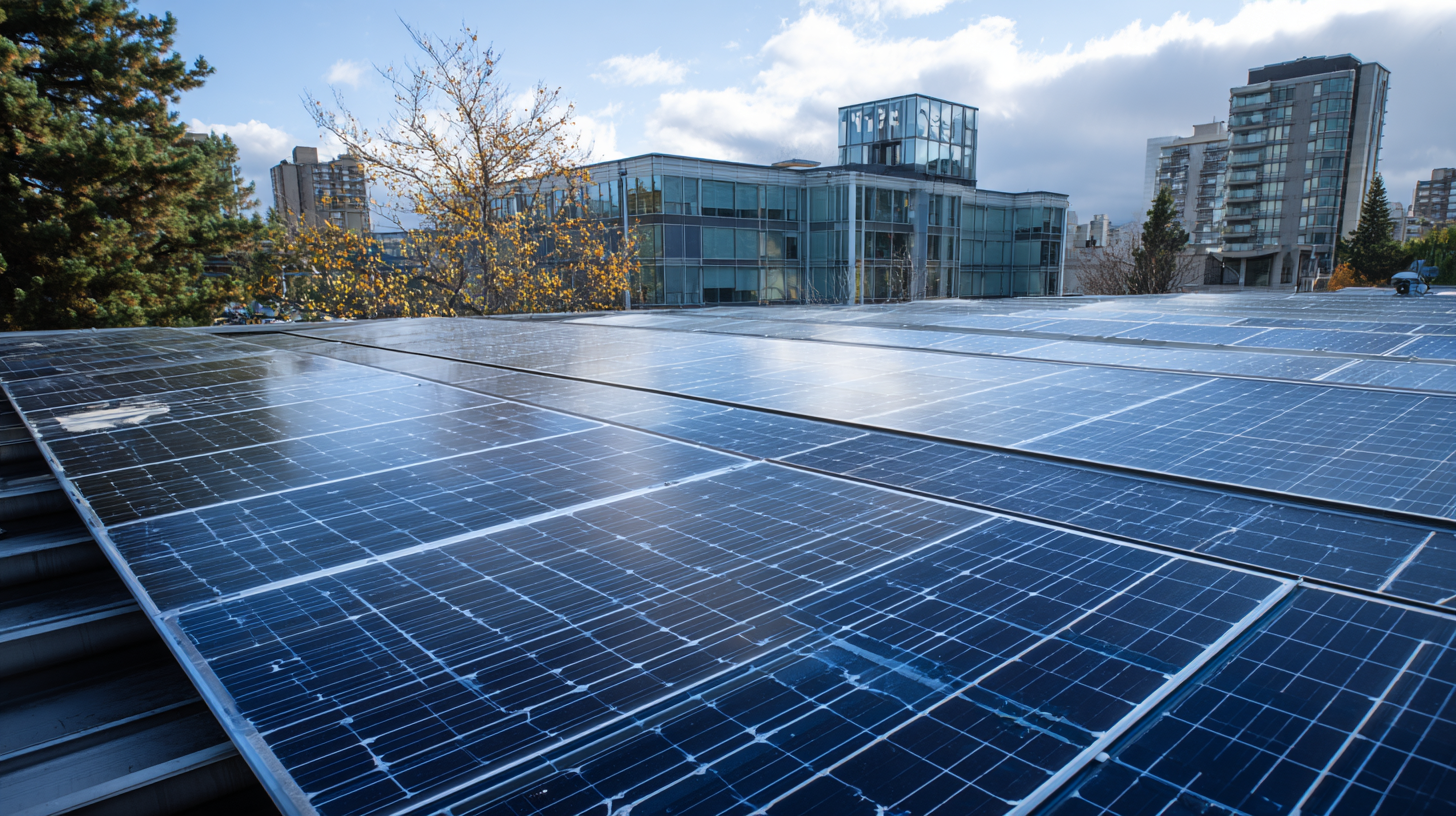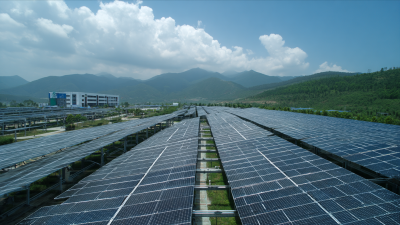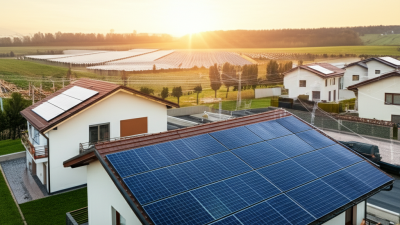
Blog
Unlocking the Future: How Solar Engineering is Revolutionizing Renewable Energy Solutions
 Solar engineering is at the forefront of innovation, driving a significant transformation in the renewable energy landscape. As global energy demands continue to rise, the adoption of solar technology presents a viable solution, with the International Energy Agency projecting that solar power could supply as much as 16% of the world’s electricity by 2050. This remarkable growth trajectory underscores the importance of advancements in solar engineering, which enhance the efficiency and accessibility of solar systems.
Solar engineering is at the forefront of innovation, driving a significant transformation in the renewable energy landscape. As global energy demands continue to rise, the adoption of solar technology presents a viable solution, with the International Energy Agency projecting that solar power could supply as much as 16% of the world’s electricity by 2050. This remarkable growth trajectory underscores the importance of advancements in solar engineering, which enhance the efficiency and accessibility of solar systems.
Innovative designs, materials, and energy storage technologies are not only improving the performance of solar panels but are also reducing costs, making solar energy more competitive with traditional fossil fuels. Reports indicate that solar energy investments reached approximately $140 billion in 2020 alone, reflecting a strong recognition of its potential as a sustainable energy source.
As we explore the revolutionary impact of solar engineering, it becomes clear that it plays a crucial role in unlocking a cleaner, more sustainable energy future.
Innovative Designs in Solar Panels: Maximizing Efficiency and Aesthetics
As the solar panel market is projected to reach $4.12 billion by 2031, innovative designs in solar technology are becoming increasingly important. With a compound annual growth rate of 12.2% from 2024 to 2031, the focus on maximizing efficiency and aesthetics is reshaping the landscape of renewable energy solutions. Despite the rapid advancements, some architects and developers remain skeptical. A recent survey revealed that 68% of architects believe solar components can detract from a building’s aesthetic appeal, while 57% of developers express concerns about increased costs and safety risks associated with solar installations.
However, cutting-edge solutions are emerging to address these concerns. The introduction of integrated solar roofing systems, for instance, aims to blend seamlessly with architectural designs, enhancing both performance and visual appeal. As homeowners increasingly prioritize functional and aesthetically pleasing options during renovations, the trend towards innovative solar solutions is likely to gain momentum. This shift reflects a growing recognition that embracing renewable energy doesn't have to come at the expense of a building's design integrity; rather, it can enhance it while contributing to a sustainable future.
Harnessing AI and Big Data for Enhanced Solar Energy Forecasting
The integration of AI and big data into solar energy forecasting is transforming the way we harness renewable energy. Traditional methods of predicting solar energy generation often fell short due to their reliance on static models and limited data inputs. However, with the advent of sophisticated machine learning algorithms, we can analyze vast amounts of data from weather patterns, historical production levels, and even satellite imagery. This analysis allows for incredibly accurate predictions of solar energy output, helping to optimize usage and increase efficiency.
Moreover, the ability to predict solar energy generation with high accuracy has significant implications for grid management and energy distribution. Energy providers can better match supply with demand, reducing reliance on fossil fuels during peak hours. As a result, the combination of AI and big data not only enhances the viability of solar energy but also paves the way for more resilient and sustainable energy systems. By harnessing these technologies, we can unlock new potential in renewable energy solutions, driving the transition toward a cleaner, greener future.
Solar Energy Generation vs. AI-Enhanced Forecasting Accuracy
This chart illustrates the increase in solar energy generation alongside improvements in forecasting accuracy due to AI and Big Data technologies from 2020 to 2023.
Revolutionary Storage Solutions: Storing Solar Energy for Continuous Use
The advancement of solar engineering is not only reshaping how we harness energy from the sun but also paving the way for innovative storage solutions that enhance the viability of solar power. Traditional solar energy systems often face challenges related to intermittency, as energy production fluctuates based on sunlight availability. However, revolutionary storage technologies are emerging to address these issues, enabling the efficient capture and retention of solar energy for continuous use, even when the sun isn’t shining.
One notable advancement in solar energy storage is the development of high-capacity batteries that can store significant amounts of energy generated during peak sunlight hours. These batteries employ cutting-edge materials and chemistries, allowing for improved energy density and longer life cycles. Furthermore, integration of smart grid technology with solar storage solutions facilitates real-time energy management, ensuring that stored energy can be dispatched when it is needed most. This synergy not only maximizes the usefulness of solar energy but also contributes to a more resilient and sustainable energy landscape, empowering users to rely on clean energy around the clock.
Policy Innovations: Supporting Solar Engineering Through Legislation and Incentives
The push for renewable energy solutions is increasingly supported by innovative policies aimed at fostering solar engineering, a crucial component in the transition to a sustainable energy landscape. According to the International Renewable Energy Agency (IRENA), solar power capacity has been growing at an average annual rate of 25% over the past decade, demonstrating the effectiveness of supportive legislation and financial incentives. For instance, the Solar Investment Tax Credit (ITC) in the United States has spurred significant investments in solar projects, with over 90% of solar installations benefiting from this initiative, contributing to a robust 100 GW of installed capacity by the end of 2022.

In addition to tax credits, various state-level policies, such as net metering and renewable portfolio standards (RPS), have proven to be instrumental in encouraging solar adoption. The 2022 Solar Market Insight Report highlights that states with strong legislative support for solar have experienced deployment rates three times higher than those with limited or no incentives. As governments prioritize renewable energy to combat climate change and increase energy security, it is evident that well-structured policy innovations will play a pivotal role in unlocking the full potential of solar engineering and accelerating the transition towards a low-carbon future.
Global Collaboration: Sharing Technologies and Best Practices in Solar Engineering
As the world increasingly turns to renewable energy, solar engineering stands at the forefront of innovation and collaboration. By sharing technologies and best practices across international borders, countries can leverage each other's strengths to accelerate the deployment of solar solutions. This global cooperation not only fosters technological advancements but also enhances the efficiency of solar systems, making them more accessible and affordable for communities everywhere.

Tip: Engage with local solar innovation hubs – Partnering with organizations that focus on solar technology can provide insights into emerging solutions and best practices. By attending workshops and seminars, professionals and enthusiasts can stay informed on the latest trends and techniques in solar engineering, ensuring they are equipped to implement effective solutions.
Furthermore, sharing obstacles and successes allows for a collective learning experience. Countries that have successfully implemented large-scale solar projects can serve as models for those just beginning their journey. Resources such as online platforms and international forums can facilitate knowledge transfer and encourage interdisciplinary collaboration.
Tip: Join online forums and networks – Actively participating in these communities can provide opportunities to exchange ideas and troubleshoot common challenges with peers worldwide. This dialogue is essential for fostering innovation and refining practices that can lead to sustainable solar solutions globally.
Related Posts
-

Understanding the Advantages of Best Solar Structure Solutions
-

Uncover the Excellence of Best Solar Engineering from Chinas Leading Manufacturers
-

Achieving Export Certification for the Best Solar Structures: A Step-by-Step Guide
-

The Ultimate Showdown of Solar Modules Performance Efficiency and Durability
-

Solar Structure Comparison: Analyzing Efficiency and Cost-Effectiveness Based on Industry Data
-

Harnessing Solar Power Solutions for a Sustainable Future and Energy Independence